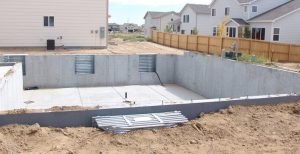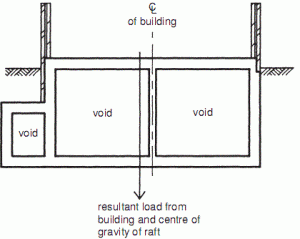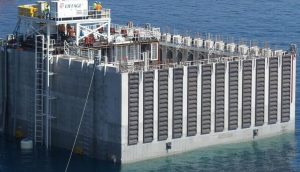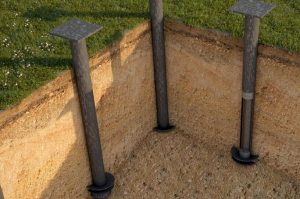Deep Foundation | Deep Foundation 6 Types & their Advantages
A deep foundation is a foundation which transfers the loads to deep strata and is placed at a greater depth, and provides lateral support and resists uplift effective.
This foundation carries building loads to more competent strata that are down too far below the ground level and from affecting their base bearing capacity deep foundation prevents the surface conditions. Below the finished ground surface, they usually go beyond 3 meters.

If unsuitable soils are present near the surface deep foundation can be used to transfer the loading to a deeper but construction process of a deep foundation is more complex and also more expensive.
To support new or existing structures deep foundations can be used and are connected to the structure and can be installed prior to building construction or underpinning elements for existing structures.
With safety in mind, these foundations are designed and in areas where earthquakes are likely to occur, the deep foundations can be especially beneficial.
Types of Deep Foundation:
There are the following types of deep foundation as given below;
- Basements
- Buoyancy Rafts (Hollow Box Foundations)
- Caissons Foundation
- Cylinders
- Shaft Foundations
- Pile Foundations
Basements:
One of the types of deep foundation to provide working or storage space below ground level is known as basements and the basements are hollow substructures and the structural design is governed by their functional requirements.

In open excavations, they are constructed and functional requirements govern their structural design.
Advantages;
There are the following advantages of basements such as;
- Basements give extra storage or working place.
- Added privacy.
- Increases home value.
- Energy efficiency and for Multi-purpose use.
Buoyancy Rafts: (Hollow Box Foundations)
To provide a buoyant or semi-buoyant substructure beneath which the net loading on the soil is reduced to the desired low intensity, buoyancy rafts are used and buoyancy rafts are hollow substructures designed and one of the types of deep foundation.

Buoyancy rafts can also be constructed in place in open excavations and can be designed to be sunk as caissons. These are used in building construction on soft and weak soils and over the soil, it reduces the load intensity.
Advantages;
There are the following advantages of Buoyancy Rafts such as;
- To stay above high water levels the building is elevated to a required height.
- There is no settlement because the total weight coming is equal to the excavated soil.
- In the durability of the underground structure, watertight material for foundations would help.
- For skyscraper construction, the foundation has a height of 3 or 4 floors is used.
Caissons Foundation:
A caisson foundation is a watertight retaining structure used as a bridge pier and used for the construction of a concrete dam and may also be used in the repair of ships.
To some desired depth, it is a prefabricated cylinder sunk or hollow box into the ground and filled with concrete and forms foundation.

In the construction of bridge piers and other structures that require foundation beneath rivers and other bodies of water, this type of deep foundation is mostly used because caissons can be floated.
By auguring a deep hole into the ground, and then filling it with concrete, the caissons are also created and for a portion of the length of the caisson, steel reinforcement is sometimes utilized.
Advantages;
There are the following advantages of caisson foundation such as;
- These are economics.
- It minimizes the need for pile cap.
- These foundations reduce vibrations and slightly less noise.
- To varying site conditions these are easily adaptable.
- These foundations have high lateral and axial loading capacity.
Cylinders:
With only single-cell cylinders are small caissons and used for water crossings and other marine applications that require foundations with the high load resistance.

For sites where water depth and potential scour result in a long free-length of pile above the mud-line concrete cylinder, piles are well suited.
Shaft Foundations:
By drilling a cylindrical hole within a deep excavation and subsequently placing concrete or another prefabricated load-bearing unit in it, shaft foundations are constructed.
Under low overhead conditions and near existing structure drilled shafts can be constructed and making them suitable for use in projects like numerous seismic retrofit projects.

Under certain conditions such as soils with boulders, soft soil, loose sand, and sand underwater, it may be difficult to install them.
Advantages;
There are the following advantages of shaft foundation such as;
- Any length and size of the pier can be constructed at the site.
- Because of the larger diameter of the shafts, an inspection of drilled holes is possible.
- By a single drilled pier foundation very large loads can be carried.
- To a wide variety of soil conditions, the drilled pier is applicable.
- During the progress of a job, changes can be made in the design criteria.
Pile Foundations:
Through driving preformed units into the required founding level or by drilling in driving tubes filled with concrete to the desired depth, pile foundations are constructed,
In different ways, tubes can be filled with concrete and they can be filled during or before the withdrawal.
When the soil constructional or economic conditions make it necessary to transmit loads of structures to strata that are beyond the reach of shallow foundations, then a pile foundation is used.

Pile foundation can be used to help resist uplift, lateral forces, and overturning and for waterfront installations, bridges, and buildings they are used as foundations.
Advantages;
There are the following advantages of pile foundation such as;
- To all difficult foundation site problems, a pile foundation provides a common solution.
- For any type of structure and for any type of soil, a pile foundation can be used.
- Reduce construction time.
- It is suitable for all sizes of land.
- For wetlands, this foundation is best.
We Love Cricket
